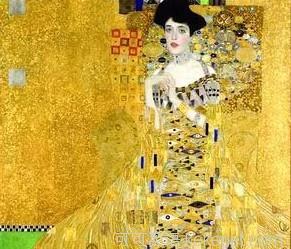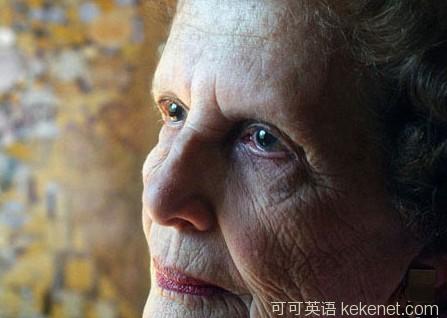(单词翻译:单击)

Obituary
逝者
Maria Altmann
玛丽亚·奥特曼
Maria Altmann, pursuer of looted paintings, died on February 7th, aged 94
被劫名画的原告玛丽亚·奥特曼于2月7日去世,享年94岁

“Suffering” was the first word that came to Maria Altmann when she was asked about Aunt Adele Bloch-Bauer. Frail, dark, beautiful, always with a headache. Children annoyed her, because she had none of her own; small-talk made her furious, because she wanted to discuss religion and politics. (“My darling,” Mrs Altmann would sigh, “Adele was a modern woman living in the world of yesterday.”) Adele smoked like a chimney, and would drift around in loose white gowns with a gold cigarette-holder. Or she would sit, regal in black, holding court for musicians, artists and writers in the salon of her huge house just by the Vienna Staatsoper.
当人们向玛丽亚·奥特曼(Maria Altmann)问及“姨妈阿黛尔·布洛赫-鲍尔(Adele Bloch-Bauer)”一事时,她说的第一句是“身心俱痛”。当年的阿黛尔有头痛症,脆弱、黝黑、美丽。孩子使阿黛尔烦恼,因为她自己没有孩子。闲聊使阿黛尔狂怒,因为她想谈论的是宗教和政治(玛丽亚·奥特曼夫人这时会一声叹息:“亲爱的,阿黛尔是一位生活于昔日尘世的现代女性”)。 阿黛尔吸烟,像个烟囱,而且,她会身着白色宽松长衣,带着金制烟斗四处游逸。有时,她会一袭黑色的雍容华贵,坐在她那大宅的客厅里,引领音乐家、艺术家、作家们海阔天空。她那大宅刚好位于维也纳国家歌剧院旁。
But the Adele the world came to know was as Gustav Klimt had painted her in 1907. It took him four years, longer than he spent on any other painting. He placed her in a swirling gown within a blaze of gold rectangles, spirals and Egyptian symbols from which she looked out in nervous loveliness, the epitome of Vienna's Golden Age. Her hands were strangely bent because, Mrs Altmann knew, she had a crippled finger, which she always tried to hide. She was also fairly sure that Aunt Adele and Klimt, with his satyr face and wild sexuality, had had a mad affair; her mother angrily denied it, said it had been just “an intellectual thing”, but you only had to look at her aunt's dark, languorous, faintly smiling eyes to think otherwise.
不过,世人最终熟悉阿黛尔是因于古斯塔夫·克里姆特(Gustav Klimt)于1907年为她作画。克里姆特为她作画耗去了四年时光,比他作的任何其它画所花的时间都长。画面上,克林姆特把阿黛勒包裹在长裙旋转之中,四周用无数金光闪烁的长方、螺旋和埃及象征图形点缀。在此背景下,她呈弥望状,具有迷离的美感,成为维也纳黄金时代的缩影。她的双手奇怪地呈弯曲状,奥特曼夫人知道,那是因为她有一根手指残了,她总是想法掩住这一残指。奥特曼也十分肯定,姨妈阿黛尔和体格强劲、性欲狂野的克里姆特曾有过一段火热的私情;虽然奥特曼的母亲愤怒地对此予以否认,说那只是“精神柏拉图行为”,然而,你审视了她姨妈阿黛尔那双黑色温柔、隐含微笑的眼睛后,你会不得不生出别样想法来。
“Golden Adele” haunted Mrs Altmann for the rest of her days. As a girl she led much the same “beautiful” life, dressed up in silk and organza, in a stately townhouse nearby, where artists and philosophers came and went to the sound of her father playing on a Stradivarius cello. After 1925, when Adele died at 43, the regular Sunday brunch at Uncle Ferdinand's would always include a viewing of the Klimt portrait, hung in Adele's bedroom in a sweet haze of fresh flowers. Four other Klimts also hung there. Three were landscapes: a beechwood, a dappled apple tree, houses by a river. The other was a later painting of Adele, pale and strained, standing in a big hat with her arms loose amid fauve colours of red, mauve and green.
《金色阿黛尔》使奥特曼夫人的晚年备受折磨。少女时,她过着与阿黛尔大致一样的“美丽”生活——穿丝绸着轻纱,住在附近富丽堂皇的联排别墅里,这是来来往往的艺术家和哲学家们听她父亲用斯特拉迪瓦里大提琴演奏音乐的地方。1925年,阿黛尔去世,43岁。之后,奥特曼姨父费迪南德家里的例行周日餐会总有一个内容是观赏克里姆特肖像画。画被悬挂于阿黛尔的鲜花散发迷蒙的芳香卧室里。克里姆特的另四贴画也悬挂在该室内,其中有三幅是风景画,一幅是山毛举林,一幅是斑纹苹果树,一幅是河边房子。另一幅是关于阿黛尔后期的油画,[画中]阿黛尔显得苍白紧张、膀腕松弛,戴一大帽站立着,四周是红、紫红和绿色映衬。
All five paintings were stolen when the Nazis took Austria over in 1938. Mrs Altmann remembered the jubilation of the Anschluss, the church bells ringing; only the Jews wept. By then, she was just married to Fritz Altmann; and she sometimes wore, next to her skin, some of Adele's diamonds, which Uncle Ferdinand had given her as a wedding present. The Nazis stole them in short order, as they also seized Ferdinand's entire art collection, his delicate porcelain and his sugar refinery. “Portrait of Adele Bloch-Bauer I”, became the symbol of all that the family had lost.
1938年,德国纳粹吞并奥地利,这五幅画全被偷走。奥特曼夫人深深记得那伴着清脆教堂钟声,唯有犹太人在哭泣的德国纳粹吞并奥地利的庆典。当时,她刚与弗里茨·阿尔特曼结婚;她有时还戴上阿黛尔的一些钻石饰品,那是她姨父费迪南德作为结婚礼物送给她的。就像纳粹夺走费迪南德的全部艺术画、精美瓷器、制糖厂一样,不久,纳粹就把这些东西也偷走了。《阿黛尔·布洛赫-鲍尔夫人画像I》成为这个家族失去一切的标志。
For many years—after she had fled to America with Fritz and made a new life in California, he working at Lockheed, she selling cashmere—Mrs Altmann supposed that the Klimt paintings had legitimately ended up in the Austrian National Gallery. But when the law changed in 1998, in favour of restitution, she vowed to get them back. The Austrian government refused. Adele's will, they said, had given the paintings to the gallery. And, they might have added, all Austria now thought it owned her golden, Klimtian beauty.
多年以来(这些年里,奥特曼与弗里茨一起逃离到了美国,并在加州开始了新生活,弗里茨在洛克希德公司工作,奥特曼出售羊绒毛),奥特曼夫人认为,克里姆特画作已是合法地属于奥地利国家美术馆了。直到1998年,在法律作出了有利于物归原主的修订后,她才发誓要让克里姆特画作回到家族。奥地利政府拒绝归还。奥府称:阿黛尔遗嘱已把这些画作赠与了国家美术馆。奥府还委婉补充到:现在,举国上下,同此观点:克里姆特画中阿黛尔的金色之美属于奥地利。
Battling in cashmere
着羊绒装的战士
Mrs Altmann went to war. At 82, in cashmere and silk scarves, she made an unlikely fighter. Her dress boutique in Cheviot Hills, where clients sat in her living room drinking Kaffee mit Schlag and nibbling on sausage, was probably the last vestige of a Viennese salon in the New World. Golden Adele, in paperweight form, lay on the coffee table and was rubbed hard for luck. But Mrs Altmann was all persistence, charm and energy—and the law was on her side.
奥特曼奔赴战场了。八十有二的高龄,穿羊绒、披丝巾的装束,使得奥夫人看起来不像一个真正的战士。她在切维厄特街区经营的服饰精品店,或许是“新世界”的最后一家古典维也纳沙龙,在这里,客户们坐在客厅,品尝奥式咖啡(Kaffee mit Schlag),细嚼香肠。咖啡桌上放着做成镇纸石的“金色阿黛勒”, 为求诉讼顺利,它被精心抚拭。奥特曼为争取胜诉,投进了她全部的毅力、智慧和物力——而法律,也站在她这一边。
Adele's will, as it turned out, only made a “kind request” to her husband to leave the paintings to the gallery. It was not binding, and in any case Mrs Altmann knew Adele's mind. She wanted the paintings left to the Vienna she knew, the vibrant, glittering, tolerant city of the early 20th century; not to a place from which all Jewish life had gone. She would never have felt at home there, as Mrs Altmann no longer did when she visited, defying security guards at the National Gallery to be photographed beside Aunt Adele, and saying loudly: “That painting belongs to me.”
阿黛尔的遗嘱表达的原本意思,只是对其夫提过一个“意向性”的要求,把画作留给艺术馆,该遗嘱并不具备法律约束力。再者,奥特曼清楚阿黛尔内心的真正意愿,那就是把画作留给她生前亲身体验的一座城市,一座在20世纪初期充满生机、灿烂辉煌、富于宽容的城市——维也纳,而不是一个别的地方,一个所有犹太人的生命都已消失的地方。阿黛尔在这个地方绝不会有归属感,就像奥特曼自己回访奥地利之后再也没有归属感一样。回访时,奥夫人在国家美术馆公开对抗安保人员的禁令,站在阿黛尔姨妈的肖像旁拍照,并大声宣示:“那幅画是我的!”
In 1999 she and her lawyer, Randol Schoenberg, tried to sue the Austrian government. When that proved too expensive, they argued as far as the Supreme Court that the case should be heard in America. They won; but then, in 2004, they went to independent arbitration. Three Austrian academics decided that the paintings should be returned. In 2006 Aunt Adele and the rest arrived with fanfare in Los Angeles: the largest single return, in monetary terms, of Nazi-looted art.
1999年,奥特曼和她的律师兰多尔·勋伯格努力起诉奥地利政府。当发现起诉费用太昂贵后,他们据理争取美国最高法院审理本案,结果遂愿。不过到了2004年后,他们转而申请独立仲裁。三位奥地利仲裁专家作出裁决:画作应当退还。 2006年,“姨妈阿黛尔”肖像与另外几幅画在礼乐曲中抵达洛杉矶:这是纳粹掠夺艺术品中单幅价值最高的回归。
Only a few months later they were sold. All but one went away to private houses. The exception was Aunt Adele. She had always wanted her golden portrait in a public gallery, Mrs Altmann said, and so it was “beautiful” that Ronald Lauder, a businessman and philanthropist who had loved Adele's face from boyhood, instantly paid $135m to enshrine her in his Neue Galerie in Manhattan. Of course, she was too far away for many visits now. But Mrs Altmann could imagine her there, glowing and frail, wearing just the faintest aroma of those long-vanished cigarettes.
也就是仅仅数月之后,尽数拍卖了回归的数画。除了“姨妈阿黛尔”肖像,它们几近都被藏之于私宅深院。奥特曼道:阿黛尔一直希望自己的金色肖像能展示于公共画廊。此愿有了一个“美丽”的结局———自孩提时就喜爱阿黛尔芳容的商人、慈善家罗纳德·劳德,在拍卖场立马付费1.3亿美元,把肖像买下,置于他在曼哈顿的画廊(Neue Galerie),供若神明。虽然,而今要常常拜见阿黛尔的话,自然是太远了点,但奥特曼尚能于此展开想像力,想像姨妈阿黛尔的热情洋溢、脆弱娇柔,想像从那已怅然远去的烟草中散发的淡淡芳香……


